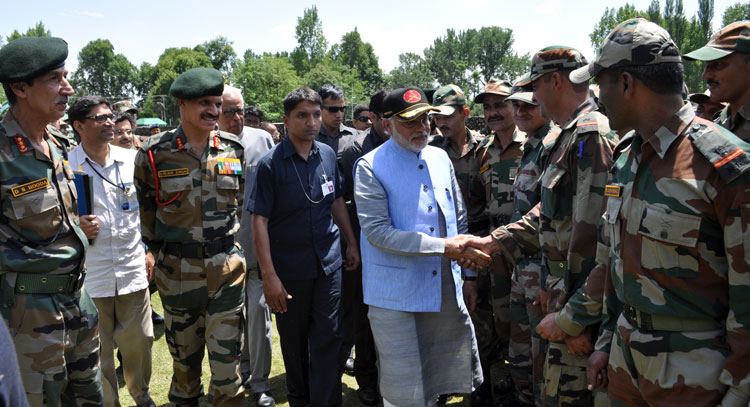Guest Column | Perception and Reality
 Lt Gen. B.S. Nagal (retd)
Lt Gen. B.S. Nagal (retd)
India declared its nuclear doctrine (summary) on 4 January 2003, a refinement of the draft doctrine made public on 17 August 1999. India had unique requirements to address in the strategic environment that forced it to operationalise the nuclear deterrent, concurrently decide on the policy, the strategy and the doctrine to be followed, from this doctrine emerged the concept of ‘Credible Minimum Deterrent’ (CMD). The doctrine is a dynamic concept related to the strategic environment, technological imperatives and the needs of national security.
India’s nuclear doctrine caters for ‘threats of use of nuclear weapons against India’ and ‘nuclear attack on India or Indian forces anywhere’. With a No First Use (NFU) policy, retaliation will be massive, designed to cause unacceptable damage. It also has provisions of nuclear retaliation in case of chemical or biological attacks.
The draft and final doctrine brought to fore certain aspects. First, nuclear weapons remain instruments for national and collective security. Second, India’s strategic interests require effective and credible nuclear deterrence. Third, the requirements of deterrence should weigh in the design of nuclear forces as well as the deterrence strategy. The deterrence strategy must provide a capability with maximum credibility, survivability, effectiveness, safety and security. Deterrence requirements include, firstly will to employ nuclear forces and weapons, secondly robust command and control system, thirdly effective intelligence and early warning capabilities, fourthly sufficient, survivable and operationally prepared forces, lastly comprehensive planning and training for operations. Since then many have debated the issue of ‘credible minimum deterrent’ (CMD) because it was a new term and did not fit the definition of ‘minimum deterrence’ as broadly accepted in western nuclear parlance.
This article seeks to examine India’s CMD, its application, development and implication for decision makers, and how firmly it is in place. Since CMD is directly linked to massive retaliation to cause unacceptable damage, therefore it should not be examined under the prism of minimum deterrence. The examination will include credibility, issues that flow from credibility, retaliation capability, arsenal requirements, force effectiveness, survivability, unacceptable damage, deterrence and strategic stability.
One of the most important principles of nuclear deterrence is credibility, to take political decisions in time to use nuclear weapons, to develop nuclear forces capability to meet the needs of deterrence, to use deterrence for national security, to signal intent to prevent threats from arising. Therefore, credibility is political and force centric, how your adversary(s) and the world views the deterrence emanating from these two determinants. When the US and Soviet Union developed their nuclear weapons, deployed the weapons and developed deterrence strategies, no one doubted their credibility or will to use the weapons, such was the intense rivalry of the Cold War. The US military, NATO and Western thinkers/think tanks developed deterrence strategies of massive retaliation/MAD/flexible response/countervailing etc, and these were integrated into nuclear strategies of NATO. The Warsaw Pact also developed deterrence strategies; this enhanced the credibility of the use of nuclear weapons. The war fighting strategies adopted by their armed forces also in no small measure contributed to enhance the credibility of the nuclear powers, to use the weapons to defend national interest, provide extended deterrence to allies, conduct ideological campaigns and seek enlarged spheres of influence.
In the Indian context, doubts are raised within and outside about the credibility of the doctrine and its application. There are two distinct views in the public domain, first that Indian political leadership in the past has failed to show resolve and will fail again. The second - but also a belief of a fair percentage - is that on nuclear retaliation decision there will be no vacillation and decision making will be prompt and decisive.
National ethos and historical precedents are important parameters to judge the decision-taking ability by the nation’s political leadership. The general perception is that Indian political leadership may be found wanting at critical junctures. The proponents of this view cite many decisions/instances or occasions when Indian political leadership failed to anticipate crisis or proactively act to avert dangers that later blew in to full-fledged embarrassments. There are historical reasons for this perception, except the 1971 war, India has been reactive during crisis, be it the 1947-48 Jammu and Kashmir operations or the 1962 Chinese aggression or the 1965 Indo-Pak conflict or the 1999 Kargil conflict. To certain terror actions such as 26/11/2008 there was inaction, the 2001 Parliament attack triggered a reaction but ended without any concrete gain. Our ability to be ahead in the decision loop has been a major failure; the capacity or potential to accept heavy cost to pursue national objectives is another negative with our political leadership, our penchant to seek consensus or defer difficult decisions even in non military matters substantiates the perception. Today, the military preparedness is not at the desired levels, once again a result of poor decision-making by the Cabinet Committee on Security (CCS). For a nation with NFU, the compulsion of civil defence is paramount. In India there is not an iota of work on public awareness or construction of nuclear defence shelters for the public, no education of civil servants or bureaucrats, and our disaster management is knee jerk and extremely limited in scope.

Prime Minister Modi meeting soldiers
There is a diametrically opposite view by many strategists/policy planners; the argument is based on strategic, political and survival compulsions. Any political leadership that decides that war is the last and only option, is then seized of all possibilities/consequences/actions that will follow from the decision. No political leadership in a democracy will seek war, that too, a nuclear war, unless the gains outweigh the loss, and if war is forced by the adversary it must be won on terms, that ensure lasting peace. Public pressure or even frenzy after a nuclear strike on India or Indian forces (anticipating escalation to mainland) will force the political dispensation to retaliate, continue the retaliation till the adversary sues for peace. Survival instinct is prime, in all political leaders, therefore, when faced with a Hobson’s choice, will take the decision in the interest of survival. National leadership has a moral responsibility to safeguard the nation and abide by existing and adopted strategies, hence bound by this responsibility; the political leadership will always take action to prevent destruction and prevail to achieve favourable termination objectives. In any war there are supporting/assisting nations with similar goals/aims/constraints, strategic interests and compulsions ensure they provide support of decision to retaliate, this is not to suggest that India becomes subservient or subordinate to friends or allies, but support helps resolve decision dilemmas. In sum total it can be said that there will be timely, firm and correct decisions by the political leadership. For this view to prevail and be accepted by the public there is a need to conduct nuclear signalling in a better way. More on this later in the article.
The second aspect of credibility is demonstrated in nuclear forces and systems capability, i.e. to retaliate in spite of attrition, degradation or destruction, and continue the retaliation till the war is terminated on own terms. The credibility of the political leader
Subscribe To Force
Fuel Fearless Journalism with Your Yearly Subscription
SUBSCRIBE NOW
We don’t tell you how to do your job…
But we put the environment in which you do your job in perspective, so that when you step out you do so with the complete picture.








